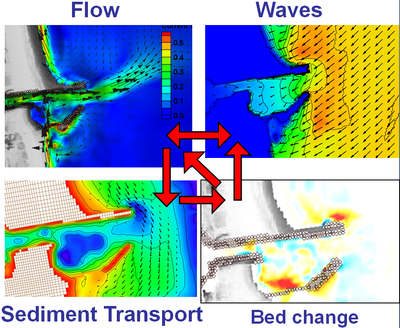CMS: Difference between revisions
mNo edit summary |
|||
| Line 89: | Line 89: | ||
'''[[Model Coupling | Coupling of CMS-Flow and CMS-Wave]]''' | '''[[Model Coupling | Coupling of CMS-Flow and CMS-Wave]]''' | ||
|style=vertical-align:top;width:33%;border-left:1px solid #aaa;padding-left:1em| <!-- Middle Column Portal --> | |style=vertical-align:top;width:33%;border-left:1px solid #aaa;padding-left:1em|<!-- Middle Column Portal --> | ||
===User Guide=== | ===User Guide=== | ||
| Line 138: | Line 138: | ||
'''[[CMS-Flow and CMS-Wave Model Coupling | CMS-Flow and CMS-Wave Model Coupling]]''' | '''[[CMS-Flow and CMS-Wave Model Coupling | CMS-Flow and CMS-Wave Model Coupling]]''' | ||
|style=vertical-align:top;width:33%;border-left:1px solid #aaa;padding-left:1em| <!-- Right Column Portal --> | |style=vertical-align:top;width:33%;border-left:1px solid #aaa;padding-left:1em|<!-- Right Column Portal --> | ||
===Examples, applications and more=== | ===Examples, applications and more=== | ||
| Line 161: | Line 161: | ||
'''Downloads''' | '''Downloads''' | ||
* [[CMS Releases]] | * [[CMS Releases]] | ||
* [[Media:CMS-SedimentTransport.xml | SMS 11.1 Sediment Transport Dynamic Dialog Definition File]] | * [[Media:CMS-SedimentTransport.xml| SMS 11.1 Sediment Transport Dynamic Dialog Definition File]] | ||
* [https:// | * [https://erdc-library.erdc.dren.mil/jspui/bitstream/11681/48392/1/ERDC-CHL%20SR-24-3.pdf CMS User Manual] [[File:New.png|alt=New|none|thumb|25x25px]] | ||
* [[Utilities]] | * [[Utilities]] | ||
* [[CMS Tips/Techniques | CMS Tips/Techniques]] [[File:New.png|25px]] | * [[CMS Tips/Techniques | CMS Tips/Techniques]] [[File:New.png|25px]] | ||
| Line 185: | Line 185: | ||
* Presentations (MVN Workshop - June 2009) | * Presentations (MVN Workshop - June 2009) | ||
** Coastal Modeling System (CMS) for Integrated Calculation of Waves, Flow, Sediment Transport, and Morphology Change [[Media:5-IntroToCMS-SMS.pdf | <nowiki>[5]</nowiki>]] | ** Coastal Modeling System (CMS) for Integrated Calculation of Waves, Flow, Sediment Transport, and Morphology Change [[Media:5-IntroToCMS-SMS.pdf| <nowiki>[5]</nowiki>]] | ||
** Introduction to CMS-Wave [[Media:6-CMS-Wave-Intro.pdf | <nowiki>[6]</nowiki>]] | ** Introduction to CMS-Wave [[Media:6-CMS-Wave-Intro.pdf| <nowiki>[6]</nowiki>]] | ||
** Additional information on CMS-Flow capabilities [[Media:7-CMS-Flow-modeling.pdf | <nowiki>[7]</nowiki>]] | ** Additional information on CMS-Flow capabilities [[Media:7-CMS-Flow-modeling.pdf| <nowiki>[7]</nowiki>]] | ||
** CMS-Wave Demonstrations to Louisiana (Levees Muddy coast) [[Media:8-CMS-Wave-examples.pdf | <nowiki>[8]</nowiki>]] | ** CMS-Wave Demonstrations to Louisiana (Levees Muddy coast) [[Media:8-CMS-Wave-examples.pdf| <nowiki>[8]</nowiki>]] | ||
** Future of the CMS [[Media:9-FutureOfCMS.pdf | <nowiki>[9]</nowiki> ]] | ** Future of the CMS [[Media:9-FutureOfCMS.pdf| <nowiki>[9]</nowiki>]] | ||
* Aug 2008 Two-Dimensional Depth-Averaged Circulation Model CMS-M2D: Version 3.0, Report 2, Sediment Transport and Morphology Change [http://www.dtic.mil/docs/citations/ADA453954 <nowiki>[10]</nowiki>] | * Aug 2008 Two-Dimensional Depth-Averaged Circulation Model CMS-M2D: Version 3.0, Report 2, Sediment Transport and Morphology Change [http://www.dtic.mil/docs/citations/ADA453954 <nowiki>[10]</nowiki>] | ||
[[category:main]] | [[category:main]] | ||
Revision as of 15:39, 9 April 2024
An Advanced Engineering Tool
The Coastal Modeling System is an integrated suite of numerical models for simulating flow, waves, sediment transport, and morphology change in coastal areas. The system is designed for practical applications in navigation channel performance and sediment management for coastal inlets and adjacent beaches in order to improve the usage of USACE Operation and Maintenance Funds. The CMS is intended as a research and engineering tool that can be used on desk-top computers. The CMS takes advantage of the Surface-water Modeling System (SMS) interface for grid generation and model setup, as well as plotting and post-processing.
- Background
The CMS has been a research and development area of the Coastal Inlets Research Program (CIRP) at the United States Army Corps of Engineers - Engineering Research and Development Center (USACE-ERDC), Coastal and Hydraulics Laboratory (CHL) since 2006. It was built from a group of numerical models that have been under development since 2002. Information on the CIRP and publications on the CMS can be found at the CIRP Website.
- Key Features
- Fully integrated system
- Finite Volume Method - Mass conservative
- Non-uniform Cartesian Grid - Easy to setup and run
- Telescoping Cartesian Grid - Flexible, efficient, and easier to generate than unstructured meshes
- Supports most common types of forcing and boundary conditions
- Robust numerical schemes for reliable, crash-free simulations
- Parallelization on desktop computers for fast computation
- User-friendly interface
System Components
CMS-Flow is a coupled hydrodynamic and sediment transport model capable of simating depth-averaged circulation, salinity and sediment transport due to tides, wind and waves. The hydrodynamic model sovles the conservative form of the shallow water equations and includes terms for the Coriolis force, wind stress, wave stress, bottom stress, vegetation flow drag, bottom and friction, and turbulent diffusion. There are three sediment transport models available in CMS: a sediment mass balance model, an equilibrium advection diffusion model, and non-equilibrium advection-diffusion model. The salinity transport is simulated with the standard advection diffusion model and includes evaporation and precipitaion. All equations are solved using the Finite Volume Method on a non-uniform Cartesian grid. For additional information on CMS-Flow visit CMS-Flow Main Page.
The CMS-Wave is a spectral wave transformation model and solves the steady-state wave-action balance equation on a non-uniform Cartesian grid. It considers wind wave generation and growth, diffraction, reflection, dissipation due to bottom friction, whitecapping and breaking, wave-wave and wave-current interactions, wave runup, wave setup, and wave transmission through structures. For additional information information on CMS-Wave visit CMS-Wave Main Page.
Documentation Portal
Technical DocumentationCMS-Flow
CMS-Wave |
User GuideCMS-Flow
CMS-Wave |
Examples, applications and more
Workshops Downloads
Advanced Features |
External Links:
- US Army Engineer Research and Development Center - Ongoing Research [1]
- Coastal Modeling System Fact Sheet [2]
- Presentations (MVN Workshop - June 2009)
- Aug 2008 Two-Dimensional Depth-Averaged Circulation Model CMS-M2D: Version 3.0, Report 2, Sediment Transport and Morphology Change [10]

